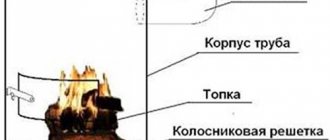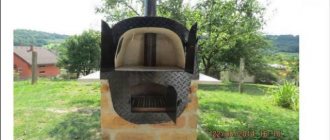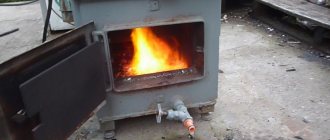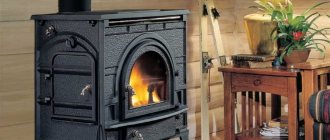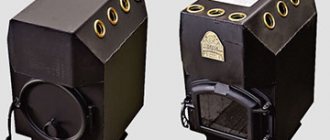Time does not stand still, everything changes - and now the designers have already reached the potbelly stove. Its updated look can harmoniously fit into and even embellish a room in an elite mansion.
We are more concerned about the question not of aesthetics, but of practicality: how to make a potbelly stove yourself, what is required for this? This article will help anyone who is planning to make this type of useful heating device on their own.
Advantages and disadvantages of a potbelly stove
A potbelly stove is a fairly common type of heating equipment. It is valued for a number of positive aspects:
- Versatility . The ability to use almost any type of solid raw material for heating: firewood, sawdust, coal, wood chips, briquettes, pellets, peat. Sometimes some models use used engine oil as fuel.
- Simplicity of design and ease of installation . This allows you to make a stove with your own hands. Moreover, any available material is suitable for this.
- Small size and weight allow this structure to be placed in a small room, in limited space.
- Perhaps the most important point is the absence of such requirements as the construction of a foundation, site arrangement, or installation of a chimney pipe.
With all the positive properties, a potbelly stove, like any equipment, has some disadvantages:
- Protection is required from combustion elements falling out of the firebox, for example, embers, sparks.
- Compliance with safety rules when working with the stove. There is a risk of burns from the strongly and quickly heating walls of the structure.
- Significant fuel consumption during operation. The best option is to use a potbelly stove for heating for a short time.
Principle of operation
Diagram of a potbelly stove
The potbelly stove is a compact device suitable for heating small rooms. With its help, you can quickly heat a room and maintain it at an optimal temperature for a long period. Such a stove does not require additional equipment; it is easily transported from one place to another, unless we are talking about a potbelly stove made of brickwork for a summer residence, and is installed without much effort.
It is not so difficult to assemble a potbelly stove yourself, for example, from bricks, barrels or old cylinders. In addition to the main structural elements, it can be supplemented with a heat exchanger, with which it will work much more efficiently. This part ensures long-lasting combustion and the necessary heat transfer when using any fuel. In order for the device to function correctly, it is worth preparing its drawing in advance, where all the details will be taken into account. A standard potbelly stove consists of the following elements:
- long burning chamber;
- ash pan;
- pipe outlet for a standard chimney;
- legs and frame;
- door with a latch.
In equipment of this type, as in other stoves, there must be a chimney with a door to maintain combustion at the required level and comply with safety standards.
Varieties of potbelly stove
There are many variations of the potbelly stove type stove design. Therefore, it will not be difficult to choose exactly the model that is ideal for a specific room: it will have a set of appropriate technical parameters, as well as satisfy its appearance. To make a potbelly stove, you can take any available material, be it a metal tank or a medium-diameter pipe, a barrel, an old gas cylinder, or sheets of iron with a thickness of at least 3 mm. The main thing is that the material is durable, with reliable walls.
As for heating a garage, any type of potbelly stove is suitable, but in a residential area, some models will be inappropriate.
We invite you to consider several types of potbelly stoves, their features, and methods for making them yourself. So, you can make the right choice in favor of the model you like.
Modernization process
Potbelly stoves went through a long stage of development before the modern version of the stove turned out. A huge number of modifications are produced, from miniature decorative designs to heating units.
Summer cottage stoves serve as an addition to the existing heating system. There is also the possibility of connecting them to boilers, which will provide residents with hot water. Stove units for cooking are equipped with hobs and ovens. They become a worthy replacement for a kitchen stove. Compact miniature analogues are indispensable assistants on a trip.
Improvement methods
Modern models are highly efficient heating devices.
In the process of developing the potbelly stove, design improvements were made that make it possible to heat fairly large rooms with an area of 50 m².
The appearance of the familiar potbelly stove has undergone minor changes. The main unit of the furnace, the firebox, was subject to modernization. The following changes have been made:
- window made of glass;
- a slow combustion process has been introduced;
- heat-resistant lining added;
- The gas re-burning system is turned on.
Model No. 1 – potbelly stove using waste oil
I would like to immediately note that this design is not suitable for use in a residential area where people are constantly present. Why? The fact is that during operation, during the combustion of waste oil, a specific aroma is released, and arranging a good exhaust hood will not help.
Materials
To create this option, the following types of material are required:
- metal sheet, several pieces, 5 mm thick. We will make all the parts and blanks from them.
- Pipes for making some structural elements.
- Pipe under the chimney.
Process of creation
The drawing below of the potbelly stove shows all the necessary parts, indicating their sizes.
So, we will divide all the work on creating a potbelly stove using waste as a raw material into successive steps:
- We mark all the necessary parts on a sheet of metal, and then cut them out using a grinding machine. The edges of the resulting workpieces must be thoroughly cleaned.
- We take a pipe of the required length and drill round holes in it. In the future, this pipe will be used to connect the upper and lower containers of the stove.
- We take the top tank and cut an opening of the required size on top. This opening will not be located in the center, but will shift to the left of it. We prepare this hole for the chimney pipe. From the bottom side we cut out an opening, shifting it to the right. It will serve as an entrance for the connecting pipe.
- We weld two circles to the part of the pipe that determines the thickness of the upper container.
- We will do the same with the bottom of the stove. But now we will cut the opening for the incoming connecting pipe in the center of the container. In addition, we need to cut another hole - a neck through which we will fill the stove with fuel. We provide a sliding cover for this hole.
- We weld 3-4 legs on the back side of the lower tank. This will ensure stability.
- To give rigidity to the structure and strengthen it, we connect both tanks to each other using metal brackets.
- The main work points are completed, it's time to think about beauty. We carefully clean the welds, and then paint the stove using heat-resistant paint. Painting the stove will also protect it from premature rusting.
- The last step is installation of the chimney pipe.
Principle of operation
The operation of this type of potbelly stove can be described as follows: pour waste oil into the lower container through the neck. Next, using a torch or paper, ignite the fuel through the opening. As soon as the oil raw material flares up in the tank, close the hole with the sliding lid.
The combustion process is enhanced by air entering the connecting pipe through the holes made. The air is heated and rises through the pipe to the upper part of the structure, while heating the surface of the container so that the kettle can easily be warmed on it. The big advantage of this model of potbelly stove is that there will be no unpleasant situations with a lack of fuel, since motorists always have used oil in the garage.
Kindling rules
Owners of private houses with stove heating may not have any difficulties with the operation of a potbelly stove. But if this is your first time encountering such a design, then you need to follow the sequence:
- for kindling you will need paper, wood chips, logs and solid fuel;
- paper is placed on the grate;
- chips and several small logs are poured on top of it;
- open the blower halfway and set fire to the paper;
- the combustion process must be monitored, and as soon as the logs are well lit, you can start adding fuel.
If coal is used to heat the dacha, then you cannot do without firewood. Coal combustion requires a high temperature, which wood chips and paper cannot provide. Potbelly stoves are compact devices that do not require a solid foundation. The design is quickly assembled and provides the necessary heat in a short period of time.
Model No. 2 – potbelly stove made from a metal barrel or pipe
For this design, a metal barrel or pipe with a certain diameter is taken. An excellent option for a house in the country, and if you assemble it beautifully and decorate it, it will look quite good in a living room, while also providing excellent heating.
Step-by-step instructions:
- Take a container for the stove and mark two rectangles. These will be the entrances for the firebox and ash pan. Cut out these holes.
- We do not throw away the cut rectangles, as they will serve as material for the doors. To do this, each door is brought to the required size, for which it is framed with strips of metal. Next we install the latch handle.
- Inside the container (barrels, pipes), moving 10 cm down from the firebox door, we attach corner brackets. Then we will place a grate on them.
- You can buy a grate ready-made, or you can make it yourself by welding it from reinforcing bars.
- If you took a pipe as a base, now you should weld its bottom and top.
- To give stability and raise it above the floor, we weld several legs to the bottom of the container.
- In the upper part of the tank we prepare an opening for the chimney pipe, where we then weld it.
- We fix the hinges and hang the doors on them. We mark and secure the hook under the lock.
- Appearance plays an important role, so the surface and seams should be cleaned. Coating the stove with heat-resistant paint will allow our design to compete with the factory model.
- When the stove structure is completely assembled, it is necessary to connect it to the chimney pipe, which we take outside to the street.
This type of stove is a good option for heating a room, provided there is enough space, since the stove is quite large. But another plus is the spacious top panel, on which you can install both a kettle and a frying pan.
What are stoves suitable for?
A potbelly stove is an excellent solution for a summer residence.
Thanks to its primitive and simple design, a potbelly stove-fireplace or a standard stove is suitable for any room that needs full heating. It can be installed in a country house, in a bathhouse, in a private or country house. Manufacturers offer a fairly extensive range of such stoves, among which you can find stylish options that can fit favorably into the interior. A potbelly fireplace designed for a country house will come in very handy during the cold season.
Inexpensive options with a chimney or an arm will be a real boon for owners of dachas and private buildings where gas cannot be piped. Modern stoves are much better than Soviet RF stoves in terms of heat retention; large devices can also be used to heat rooms with an impressive area. The market also offers quite expensive options of various sizes with excellent design and an increased level of fire safety, including sauna or wood-burning stoves.
When choosing a device, it is important to determine in advance for what purposes it will be used, since modern potbelly stoves are suitable not only for heating. They can be used for cooking or as a decorative element.
Model No. 3 – potbelly stove made from a gas cylinder
The gas cylinder has an almost ideal, ready-made shape for the stove structure. A potbelly stove made from a cylinder is well suited for heating garages and country houses.
Let's look at how you can build a stove from a cylinder:
- Let's start by cutting off the top part of the cylinder where the tap was located and welding a plug here.
- Next, cut a square opening at the bottom of the cylinder. This will be the entrance to the firebox. We will not throw away the cut off part, as we will make a door out of it. You just need to scald this part, bringing it to the desired size.
- We weld the hinges, install the door, and attach the handle-lock to it.
- We make holes on the side of the cylinder that will become the bottom of the structure. They will take on the function of the grate.
- We prepare the box, making it from metal of a smaller thickness, and secure it under the holes - with a grate. The box will play the role of an ash pan, into which the remains of combustion products fall, and at the same time acting as an ash pit. You need to attach a door to the ash pan.
- All that remains to do for the stove structure is to make the legs. To do this, we will use a pipe or a metal corner. Using welding, we attach them to the bottom of the fuel tank.
- In the upper part, on the opposite side of the firebox, we cut an opening in the ash pan and weld the chimney pipe.
- If desired, you can build a cooking panel on the top surface of the stove. This is done simply - a frame made of steel reinforcement is welded. This panel turns out to be quite roomy; you can place two items at the same time.
What kind of chimney is needed?
Chimney for a potbelly stove
Without a chimney, it will be impossible to use a potbelly stove, so you should take care of the manufacture of this part in advance. To make a pipeline, you can purchase ready-made pipes or make them yourself from sheet metal. The second option will be cheaper. During the assembly process, a smoke channel is assembled from pipes and a corner element, which is then welded to the finished potbelly stove.
The material used for the chimney is brick, steel or other metal pipes, ceramics, vermiculite or asbestos cement. You should choose the appropriate option based on your budget and installation complexity.
Sometimes chimney pipes are made of special heat-resistant glass, but working with this material requires special skill. Glass chimneys are also not very practical.
The optimal choice for beginners will be ready-made stainless steel pipes; their main advantages are: light weight, reasonable price and lack of difficulties at all stages of assembly.
Model No. 4 – rectangular stove
According to many experts, this type is considered the most optimal, aesthetic, and compact of all the previously listed models of potbelly stoves. This design is perfect for heating a living space.
A rectangular potbelly stove can be made in two variations:
- The first is the Gnome stove. Compact, simple model, consisting of two chambers, a firebox and ash pan, a chimney pipe and legs.
- The second is more complex, retaining heat for a long time. This is a Loginov stove. Therefore, it deserves detailed consideration.
Main purpose
The main task of a rectangular potbelly stove is to heat a room up to 15 square meters in size. m. An ordinary potbelly stove is characterized by rapid heat transfer, but at the same time it cools down very quickly as soon as the wood burns out. This disadvantage can be partially eliminated if you line the stove with bricks. But this is not an option, since bricks will significantly slow down the rate of heat transfer, and retain thermal energy only for a short time.
Modernization of the furnace device
Changes made to the design of the potbelly stove and a different method of fuel supply made it possible to improve the performance properties. At the same time, its main positive characteristics were preserved: fast heat transfer, small dimensions, ease of installation and arrangement, without additional construction of a foundation or creation of a capital pipe.
What did you do for this? In the fuel tank itself, its upper part, 2 plates were welded, which form a labyrinth. Thus, the path of gases has been increased, which means they leave more heat in the oven. Due to the expansion of metal surfaces, heat exchange between gases and the walls of the container has become more efficient.
The fire-fighting components of this model have also been improved: its chimney does not heat up, but remains hot. Proper placement of the pipe head will provide sufficient traction. In this case, the head is placed so as to exclude being in a high pressure zone, no matter what the wind is. Therefore, it would be better to install it higher than the roof ridge.
Criterias of choice
When choosing the power of the unit, consider the area of the premises that you need to heat; Decide on the type of fuel to light the stove; Select the appropriate material from which the combustion chamber will be made. Cast iron is more durable. As it heats up slowly, it also cools down slowly.
Steel fireplaces are more inexpensive. Heating of such an installation is fast, as is cooling; The firebox can be additionally equipped with a hob or oven; Pay attention to the functionality and security level of the installation
It is important that the structure is reliably protected from strong heat, cools slowly and consumes fuel economically; In order for soot and ash to be removed quickly, it is recommended to give preference to a fireplace equipped with a retractable ash pan.
Fireplaces made in Russia and Belarus are no less popular. Since the winters in these countries are no less severe, the products actually work and can cope well with the problem of heating homes. The advantages of fireplaces made in Russia and Belarus include affordable cost, high power, functionality and stylish design.
Bottom line
We have reviewed the most effective potbelly stove that you can make with your own hands. Unfortunately, there is no clear leader among them. There is a different option for each condition.
But still, the most effective potbelly stove can be called a working furnace. It has maximum efficiency, since there is a pyrolysis effect (after-burning of gases).
In second place is a rectangular potbelly stove with an internal labyrinth of gases. This also significantly helps increase efficiency.
I would like to note that each of the furnaces has great potential for modifications and improvements. There are a lot of different options on the Internet on how to increase the efficiency of a potbelly stove. From directing a fan at it to creating a water circuit. We will cover these points in a separate article.
Pages of history
This type of stove got its name because of its unique appearance. In America, at one time, a stove was widespread - the fat belly. It was actively used for heating small internal volumes, premises of railway stations, freight cars, temporary premises such as guardhouses and other similar types.
Such stoves came to Russia along with the American occupation corps at the turn of the First World War and at the dawn of the Civil War, and immediately attracted the attention of local residents, who immediately appreciated the simplicity and, at the same time, proper efficiency of the stove. And then, along with the civil war, devastation came and simple but effective designs became in great demand.
In general, the potbelly stove has spread across the country. Heat, along with food, is a fundamental factor in a minimally equipped life, and an individual stove, even if it was heated with trees from the family garden or marvelous half-chairs made by the English master Gumbs, could be afforded by fairly wealthy people, in a word, bourgeois.
Potbelly stoves successfully survived the civil war and devastation, collectivization and the Stakhanov movement, worked conscientiously in the dugouts and dugouts of the Great Patriotic War, and confidently entered the post-war life of ordinary Soviet people, heating barracks, dachas and sheds. The decline of stoves of this design came at the time of the mass introduction of centralized heating systems in the country, and now, when industrial technologies make it possible to do things cheaply and cheerfully, and manual electric welding has become commonplace, such stoves are experiencing a rebirth. How is it structured?
How to distinguish a fake from the original?
Sometimes sellers, out of ignorance or in order to deceive the buyer, pass off other stoves as potbelly stoves. It is worth knowing that this is not a POV-57 potbelly stove if the description states:
- The stove is not made of gray cast iron.
- There are not two doors on the case, but one.
- The stove is too massive - it deviates significantly from the standard dimensions of 53x39x39.
- The stove is too small, weighing less than 30 kg (a product made of high-quality gray cast iron is never lightweight).
- The instructions indicate that it is heated with 1 type of fuel.
To avoid falling for scammers, it is better to buy stoves for houses or garages in trusted stores. First read the reviews of the seller, check the product certificates (a conscientious seller will always show product documents at the client’s request).
